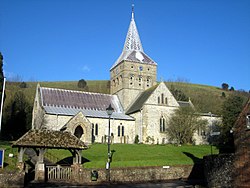East Meon
| East Meon | |
| Hampshire | |
|---|---|
 All Saints Church, East Meon | |
| Location | |
| Grid reference: | SU680221 |
| Location: | 50°59’38"N, 1°1’59"W |
| Data | |
| Population: | 1,171 (2011) |
| Post town: | Petersfield |
| Postcode: | GU32 |
| Dialling code: | 01730 |
| Local Government | |
| Council: | East Hampshire |
| Parliamentary constituency: |
East Hampshire |
East Meon is a village in eastern Hampshire, in the East Meon Hundred, four and a half miles west of Petersfield and almost twenty miles north of Portsmouth.
The village sits in the Meon Valley, by the infant River Meon.
About a mile to the west rises a prominent hill, Henwood Down (659 feet). The South Downs Way passes over the southern spur of the hill.
Contents
History
There are Bronze Age burial barrows within the parish which date back to around 2000 BC. An Iron Age fort is to be found just outside the parish boundaries crowning Old Winchester Hill, constructed approximately 500 years before the Romans invaded Britain. There is also evidence of Roman occupation in and around the village.
East Meon itself may have been founded in the Saxon period, somewhere between the years 400 and 600. Then it was part of a Royal Manor belonging first to King Alfred the Great who left it in his will to his youngest son Æthelweard (c.880-922). The Domesday Book of 1086 shows that the Manor then belonged to the King; it records six mills and land for 64 ploughs.
About 1280 a family from East Meon, who changed their name to de Meones, moved to Dublin, where they became substantial landowners and gave their name to the suburb of Rathmines.
Opposite the church is the old Court House, with a mediæval hall dating from the late 15th century.[1] At this time, and for many centuries, East Meon belonged to successive Bishops of Winchester. The Court House was its administrative centre and home to a number of monks who played host to the Bishop when he visited East Meon. They also recorded all manorial imports and exports.
East Meon played its part in the Civil War of the 1640s. The Parliamentarians camped near the village before the Battle of Cheriton in 1644, and it is said that they stole the lead lining from the font to make their bullets. The battle turned out to be a turning point in the war. During the Second World War, the Luftwaffe dropped 38 high explosive bombs and an estimated 3,500 incendiary bombs in the Parish; the only loss of life, however, was a pig.
In 1986, the 900th anniversary of the Domesday Book, East Meon was chosen as "The Domesday Village", with a model in Winchester Castle's Great Hall depicting the village as it was then – the model can still be seen alongside the famous tapestry at Bayeux in Normandy.[2]
All Saints' Church
The village church, named "All Saints," was built after the Norman Conquest, and dates between 1075 and 1150. It resembles Winchester Cathedral in style, and like the cathedral, it contains a black marble font created at Tournai, in what is now Belgium, c. 1130–40. The Tournai font is one of four such fonts in the county of Hampshire. Inside the church, there is a stone, which has the words "Amens Plenty" carved into it, which is said to sit atop the graves of four men buried in the standing position.
Big society
There is an annual May Fair.
Many local orhansiations are activem including:
- The East Meon Garden Club organises two East Meon Gardens Open Days, in April and June, evening meetings, two visits to gardens and the opportunity to buy seeds and plants, fertilisers and bulbs at discounted prices. It runs a Plant Sale and the annual Flower Show.
- The Care Group arranges transport for vulnerable residents to local surgeries and hospitals
- A weekly lunch is held in the Village Hall, open to local residents over the age of 60.
- Local charities:
- Forbes Almhouses are perhaps the longest-established institution in East Meon for administering help to the poor and elderly: their aim is to provide basic housing for those of very limited means.
- The Sexton, an independent organisation, funds work on the more unruly sections of the graveyard of All Saints, though it has no direct links to the church itself.
- The Good Causes fund is a general local charity: numerous causes have benefited from the £29,000 donated since the Fund's inception including the Village Hall, youth organisations, the Luncheon Club, East Meon School, Meon Matters, junior sports activities and the Queen's Golden Jubilee and Millennium celebrations.
Village Hall
The Village Hall is a venue with one large hall and a smaller room attached, together with a kitchen, toilets and a stage.
Sport
- Cricket: East Meon Cricket Club
Outside links
| ("Wikimedia Commons" has material about East Meon) |
References
- ↑ Nikolaus Pevsner: The Buildings of England: Hampshire & The Isle of Wight, 1967 Penguin Books ISBN 978-0-300-09606-4page 200
- ↑ Milne, Tony (2020). Myth of England. Handmaid Books. p. 38. ISBN 9798608243073.
